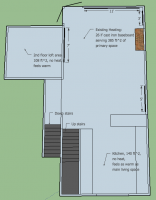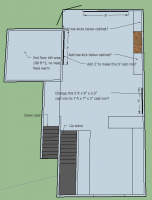DIY Todd
New Member
I am a DIY’r with some plumbing experience, but my plumbing vocabulary/knowledge is pretty basic. I have already successfully added cast-iron baseboard myself. I have help that is more experienced available if necessary.
Here is my primary issue. I want to add built-in cabinets on either side of my fireplace. To do so, I need to remove 5 lf of the existing cast-iron baseboard. As it is, the system keeps the space adequately warm, but on very cold days, like 20F and lower, it seems like the boiler is called often and the system has a hard time keeping the space at 68F without running quite frequently. I am concerned that if I remove 5 lf of baseboard it will make the problem worse and the system will have a hard time maintaining a comfortable temp. Here are the options I am considering:
- Put toe-kick heaters under both cabinets that will be put in.
- Make up the 5 lf of lost baseboard by adding 2 ft onto one of the existing baseboard lengths that is staying, and possibly 2 ft onto another. I will still end up with less baseboard than we currently have. Also, to do this I have to take apart and subtract/add to each of the 3 lengths of baseboard.
- Combo of option 1 and 2 which is the most expensive and most work.
Some details:
- The loop runs in a series
- The boiler is in the basement directly below the room
- The ceilings are 15’ high at the ridgeline sloping down to 8’ in living area
- The main living space is 385 ft^2
- The adjoining kitchen, is 140 ft^2 with no additional heat. The temperature feels the same as main space (open concept).
- A ladder leads to an adjacent unheated 2nd floor, loft area of 108 ft^2 of space which also does not get colder than the main space
- I have extra baseboard available so I don't need to purchase the extra lengths to add to existing lengths.
Questions
- Toe kick heaters would be served by 1/2” while the existing zone is served by 3/4” copper. If I go with the toe-kick option and I put them into the loop in parallel using mono-flow tee’s will their addition add to the overall heat in the room and compensate for the loss of 5 lf of cast iron baseboard? Or, will their 1/2” supply/return, even putting them in parallel with mono-flows, just become an expensive, but negligible addition to the system? I’m concerned that the added resistance will offset any gains by adding them.
- Am I better off getting back the baseboard lost by adding to the other baseboards?
- Doing both toe-kicks and adding to the existing baseboard may be the best option, but the most work, cost, and aggravation. I’d rather not take that route if options 1 or 2 is predicted to be sufficient.
- To add to the one length of baseboard, I’d be swapping out 5 ft of 9” x 2/5” cast-iron for 7-ft of 7” x 2” cast-iron. Although the second baseboard will be longer, it actually comes out to less cast-iron baseboard volume wise. So, is this even making the situation better on that length? Is thinking about the amount of cast-iron baseboard volume wise instead of length accurate to the way they work?
- Or, should I just reduce the existing baseboard by the 5ft and hope for the best? Perhaps whether or not it’s 26 ft of baseboard or 21 ft of baseboard the outcome may be the same as it may be more of a insulation/heat loss issue?
I greatly appreciate any and all advice on these matters.
Todd
Here is my primary issue. I want to add built-in cabinets on either side of my fireplace. To do so, I need to remove 5 lf of the existing cast-iron baseboard. As it is, the system keeps the space adequately warm, but on very cold days, like 20F and lower, it seems like the boiler is called often and the system has a hard time keeping the space at 68F without running quite frequently. I am concerned that if I remove 5 lf of baseboard it will make the problem worse and the system will have a hard time maintaining a comfortable temp. Here are the options I am considering:
- Put toe-kick heaters under both cabinets that will be put in.
- Make up the 5 lf of lost baseboard by adding 2 ft onto one of the existing baseboard lengths that is staying, and possibly 2 ft onto another. I will still end up with less baseboard than we currently have. Also, to do this I have to take apart and subtract/add to each of the 3 lengths of baseboard.
- Combo of option 1 and 2 which is the most expensive and most work.
Some details:
- The loop runs in a series
- The boiler is in the basement directly below the room
- The ceilings are 15’ high at the ridgeline sloping down to 8’ in living area
- The main living space is 385 ft^2
- The adjoining kitchen, is 140 ft^2 with no additional heat. The temperature feels the same as main space (open concept).
- A ladder leads to an adjacent unheated 2nd floor, loft area of 108 ft^2 of space which also does not get colder than the main space
- I have extra baseboard available so I don't need to purchase the extra lengths to add to existing lengths.
Questions
- Toe kick heaters would be served by 1/2” while the existing zone is served by 3/4” copper. If I go with the toe-kick option and I put them into the loop in parallel using mono-flow tee’s will their addition add to the overall heat in the room and compensate for the loss of 5 lf of cast iron baseboard? Or, will their 1/2” supply/return, even putting them in parallel with mono-flows, just become an expensive, but negligible addition to the system? I’m concerned that the added resistance will offset any gains by adding them.
- Am I better off getting back the baseboard lost by adding to the other baseboards?
- Doing both toe-kicks and adding to the existing baseboard may be the best option, but the most work, cost, and aggravation. I’d rather not take that route if options 1 or 2 is predicted to be sufficient.
- To add to the one length of baseboard, I’d be swapping out 5 ft of 9” x 2/5” cast-iron for 7-ft of 7” x 2” cast-iron. Although the second baseboard will be longer, it actually comes out to less cast-iron baseboard volume wise. So, is this even making the situation better on that length? Is thinking about the amount of cast-iron baseboard volume wise instead of length accurate to the way they work?
- Or, should I just reduce the existing baseboard by the 5ft and hope for the best? Perhaps whether or not it’s 26 ft of baseboard or 21 ft of baseboard the outcome may be the same as it may be more of a insulation/heat loss issue?
I greatly appreciate any and all advice on these matters.
Todd
Attachments
Last edited:


